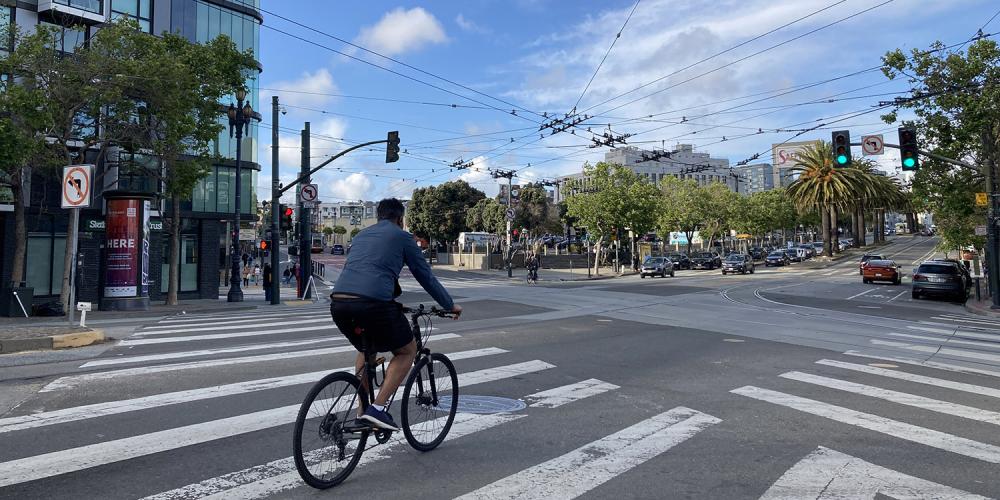
Why Consider a Local Road Safety Plan (LRSP) or Vision Zero Action Plan (VZAP)?
Key reasons for developing a LRSP/VZAP include:
- Providing a framework for systematically addressing traffic safety issues in a given jurisdiction with context-specific physical and programmatic solutions.
- For a VZAP, providing a clear safety goal for the community and jurisdiction staff to target when designing implementation programs.
- Increasing opportunities to access funding for roadway projects, such as funding through the Active Transportation Program (ATP), California Office of Traffic Safety (OTS) Grant Program, Highway Safety Improvement Program (HSIP), several SB 1 funding streams, and the Rebuilding American Infrastructure with Sustainability and Equity (RAISE) Discretionary Grant Program.
- Supporting the jurisdiction’s designation as a Connected Community Priority Development Area (PDA) and access to related MTC funding opportunities, if adopted in concert with a Bicycle and Pedestrian Infrastructure Action Plan.
What is a Local Road Safety Plan/Vision Zero Action Plan?
A LRSP or VZAP is focused on improving pedestrian and bicycle safety and provides a framework for identifying, analyzing and prioritizing roadway safety improvements on local roads. The plan development process is tailored to local issues and needs and leverages a system-wide, data-driven analysis of collisions to generate a prioritized list of issues, risks and countermeasures that can be used to reduce fatalities and serious injuries. An LRSP, VZAP or comparable systemic safety plan is required to be eligible for Highway Safety Improvement Program (HSIP) funding.
Core elements of both an LRSP and a VZAP include:
- Collision database development and proactive analysis of local collision data to identify high-risk locations and collision patterns and trends
- Identification and prioritization of system-wide safety improvements, including identification of “Quick-Build” or other types of rapid implementation projects along with longer-term countermeasures
- Development of an implementation program, including identification of potential funding sources
Some communities prefer to enhance their safety planning by adopting a Vision Zero policy, which establishes a goal of achieving zero traffic deaths and severe injuries by a target date. To help implement this policy, a VZAP includes the following additional core elements:
- Adoption of a Vision Zero policy with a “zero goal” for traffic deaths and severe injuries
- Extensive community engagement and assessment of equity issues and the disproportionate impacts of safety outcomes on a community’s most vulnerable members
- Identification of a High Injury Network (HIN)
- Monitoring and publication of progress toward the “zero goal”
Jurisdictions with a Connected Community PDA may use a LRSP or VZAP and complementary BPIAP to satisfy MTC’s Vehicle Miles Traveled (VMT) reduction planning requirements for Connected Community PDAs.
What Kinds of Communities Should Consider Developing a Local Road Safety Plan/Vision Zero Action Plan?
- Communities interested in improving safety, mobility and accessibility for all road users and encouraging greater use of active transportation modes
- Communities that have a champion invested in involving a wide range of departments and stakeholders to achieve ambitious safety targets through employment of a Safe Systems Approach to infrastructure improvements and supportive programming
Key Planning Steps
The steps to develop a LRSP/VZAP are listed below. Refer to the LRSP/VZAP Policy Development Guide for more detailed guidance.
- Establish leadership and clarify plan objectives
- Identify a champion
- Convene a working group
- Identify and contact stakeholders
- Decide whether to pursue a LRSP or VZAP
- Coordinate program
- Develop a vision statement and goals
- Gain leadership support
- Solicit consultant services if desired
- Develop and release an RFP (LRSP/VZAP Request for Proposals Template)
- Review proposals and select a consultant
- Finalize the contract
- Develop the plan
- Develop an engagement plan (LRSP/VZAP Engagement Plan Guidance)
- Collect data and/or facilitate access to data sources
- Review existing plans and policies (LRSP/VZAP Policy Review Worksheet)
- Conduct the technical analysis (see scope of work included in the LRSP/VZAP Request for Proposals Template)
- Develop the plan document
- Develop the Vision Zero Policy (VZAP only)
- Draft staff reports to support council action (LRSP/VZAP Staff Report Guidance)
- Develop presentations to support community engagement and council action (LRSP/VZAP Presentations Worksheet)
- Evaluate and update the plan
- Evaluate the plan
- Update the plan
- Implement the improvements (see Bicycle and Pedestrian Infrastructure Action Plan Resource page)
- Identify grant opportunities
- Review the current Capital Improvement Plan
Sample Documents
In addition to the guidance linked in the key planning steps above, the following sample documents are provided:

